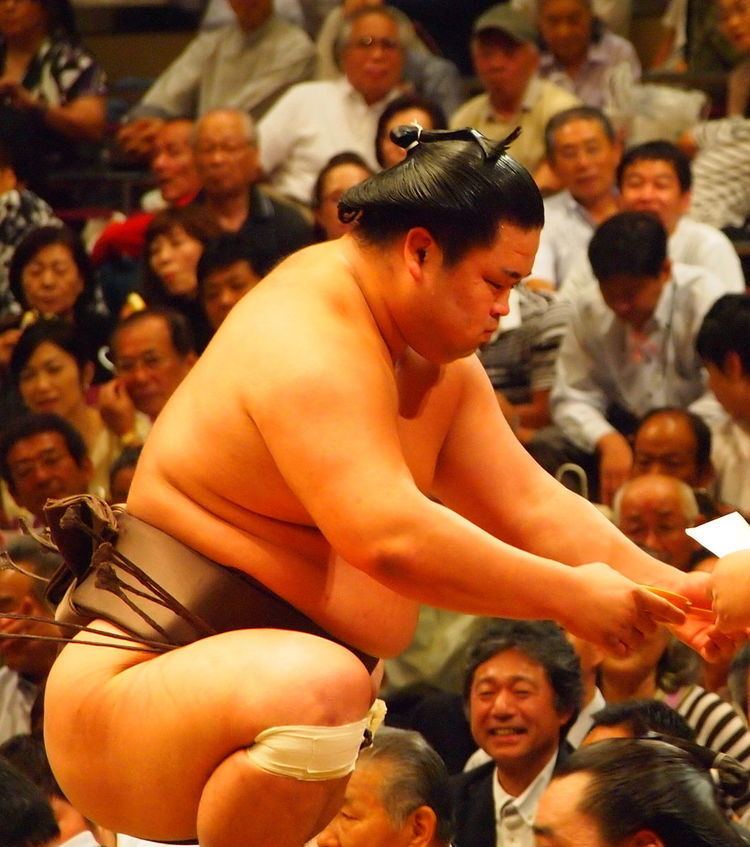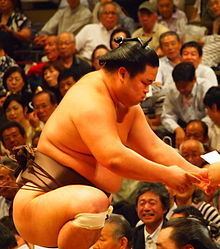Current rank see below Highest rank Sekiwake (Sept 2012) Name Myogiryu Yasunari Makuuchi rank Sekiwake (since 2012) Weight 145 kg | Debut May 2009 Special Prizes Technique (5) Role Sumo Wrestler Height 1.87 m | |
 | ||
Born Yasunari Miyamoto October 22, 1986 (age 38) Hyogo, Takasago city, Japan ( 1986-10-22 ) Championships 2 (Juryo)1 (Makushita) Similar People Tochiozan Yuichiro, Goeido Gotaro, Kotoshogiku Kazuhiro, Terunofuji Haruo, Kisenosato Yutaka | ||
Myōgiryū Yasunari (妙義龍 泰成, born 22 October 1986) is a professional sumo wrestler from Takasago city in Hyōgo prefecture, Japan. Making his debut in May 2009 as a makushita tsukedashi out of university, he reached the top division for the first time in November 2011. His highest rank to date has been sekiwake. He has earned five special prizes for Technique.
Contents
Early life and sumo background

Miyamoto was a member of an area sumo club in elementary school and in junior high school he participated in a national athletic meet as a sumo participant. He transferred to a high school in Saitama prefecture, and in 2004 participated in a sumo event along with his schoolmate, the future Gōeidō, and in group competition came in second place to Gōeidō's first. In 2008, as a fourth year university student at Nippon Sport Science University, he won a national sumo tournament in Ōita prefecture, and qualified to enter professional sumo as a makushita tsukedashi. He received invitations from several sumo stables, and eventually chose Sakaigawa stable which Gōeidō had previously joined.
Career
His first tournament was in May, 2009. His debut at makushita 15 was the highest since Daishoumi in March, 2007. He was reported to have been gunning for equaling Takateru's makushita tsukedashi debut 7-0 championship, but soon ran into trouble, losing his very first match. He was apparently taken aback at the size of wrestlers in professional sumo and their tendency to not touch both fists to the ring before the initial charge. He eventually found his bearings and pulled out a 5-2 winning tournament. He would follow this with three more consecutive 5-2 tournaments, which would carry him straight into jūryō for the January 2010 tournament. On promotion to jūryō he changed his ring name to Myōgiryū, meaning "dragon of many skills" a name suggested by a former teacher at his university.
Myōgiryū convincingly beat Jūmonji in his first jūryō match but on only the second day, severely injured his left knee in a bout against Gagamaru and dropped out of the tournament. He was forced to sit out the next three tournaments due to his injury and his rank had dropped to bottom ranks of sandanme, a division he had never fought in before, by the time he returned in the September 2010 tournament. He lost no time though, achieving a perfect 7-0 record in his post injury debut and narrowly losing the sandanme championship in a playoff loss to his upperclassman from his former university, Chiyozakura. In the following tournament, on his re-promotion to makushita he would top this feat, posting 6 straight wins after losing his first bout, and going on to take the championship after a 4-man playoff. After two more convincing kachi-koshi tournaments in makushita he was back in jūryō, the division in which he had only fought two bouts. Undeterred by his first brush with bad luck at this level, he posted an 11-4 record and beat Masunoyama in a playoff for the championship.
In his second full tournament at jūryō Myōgiryū racked up an even more convincing 13-2 record and a consecutive championship. This would secure his entry into the top division in the 2011 November tournament. Coincidentally, he entered in the same tournament as senior wrestler Tsurugidake who 8 years before had entered sumo under the same ring name of Miyamoto, the surname they share.
Myōgiryū managed a winning record of 10-5 and advanced in makuuchi to maegashira 5 for the January 2012 tournament. He produced another strong performance there, scoring 9-6 and winning his first sanshō or special prize, for Technique. He won his second Technique Award in the May tournament. In the following July tournament he made his san'yaku debut at the rank of komusubi, and came through with a winning record and his third Technique Award. He was promoted to sekiwake for the September tournament, the second from his stable to reach sumo′s third highest rank after Gōeidō. He won ten bouts and his fourth Technique Prize in the last five tournaments.
After a losing record in November Myōgiryū was ranked at maegashira 1 for the January 2013 tournament. He earned his first kinboshi for a yokozuna upset by defeating Hakuhō on Day 3, but missed out on a special prize as he could only finish with a losing record of 7–8. In May he defeated another yokozuna, Harumafuji, and two ōzeki, and was rewarded with his fifth Technique prize for the tournament after a strong 11–4 score. His success continued, with two sekiwake appearances in the following July and September tournaments. He would fall back to maegashira 1 in November 2013, but a winning tournament would put him back in san'yaku at komusubi for the January 2014 tournament. He lost his first four bouts in this tournament and dropped out due to injury. This would drop him to maegashira 10 in March, but two consecutive 8-7 winning tournaments would put him back in upper makuuchi for the July 2014 tournament. He scored 11-4 there, which returned him to sekiwake for September, but he had to miss the whole of that tournament through injury and dropped back to the maegashira ranks. Nine wins in November and nine more in January 2015 saw him back at komusubi for the March tournament where eight wins were sufficient to gain promotion to sekiwake again. He dropped back to komusubi for July, but was promoted to sekiwake for the fourth time for the September tournament. He lost his sekiwake rank in November 2015 after a poor 2–13 record, and has spent 2016 in the maegashira ranks.
Myōgiryū is popular with female sumo fans, some of whom call out his nickname "22" at tournaments, apparently a reference to his body fat percentage.
Fighting style
Myōgiryū is a pusher thruster who prefers oshi-sumo techniques. His most common winning kimarite is oshi-dashi, a straightforward push out, which has accounted for about half his career victories so far.
